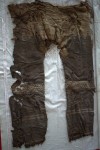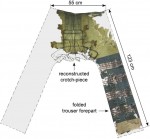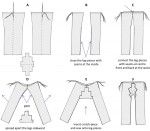 The oldest known trousers in the world have been found in two tombs of the Subeixi culture in northwestern China. The burials are among more than 500 that have been excavated in the Yanghai cemetery near the city of Turfan since the first grave was discovered by local villagers in the 1970s. The cemetery is in a gravel desert, an arid climate that can get as hot as 122°F in the summer and as cold as -20°F in the winter, which ensures the preservation of organic material like human and animal remains, plants and textiles.
The oldest known trousers in the world have been found in two tombs of the Subeixi culture in northwestern China. The burials are among more than 500 that have been excavated in the Yanghai cemetery near the city of Turfan since the first grave was discovered by local villagers in the 1970s. The cemetery is in a gravel desert, an arid climate that can get as hot as 122°F in the summer and as cold as -20°F in the winter, which ensures the preservation of organic material like human and animal remains, plants and textiles.
 The woolen pants were found in tombs M21 and M157. The ones in the former are almost complete, while only fragments of the trousers were found in the latter. Radiocarbon dating analysis on samples of the fabric from both pairs found that the M21 pants date to 1122-926 B.C., while the M157 pants may be slightly older at 1261–1041 B.C. That makes these finds centuries older than the oldest Scythian pants (5th to 3rd centuries B.C.).
The woolen pants were found in tombs M21 and M157. The ones in the former are almost complete, while only fragments of the trousers were found in the latter. Radiocarbon dating analysis on samples of the fabric from both pairs found that the M21 pants date to 1122-926 B.C., while the M157 pants may be slightly older at 1261–1041 B.C. That makes these finds centuries older than the oldest Scythian pants (5th to 3rd centuries B.C.).
This period marked the shift from settled farming and herding communities to nomadic pastoral lifestyles on horseback in central Asia. The bit and harness made controlling the horse at high speeds over long distances or during battle possible, but now the riders needed an article of clothing that would allow them to side astride while protecting their legs and genitals. The tunics, gowns, and the combination of loincloth and individual leggings tied to a waistband like Otzi the Iceman was wearing 2,000 years earlier when he died in the Alps weren’t going to do the trick.
It was the invention of the crotch that ushered in the era of the trousers. The crotch joins the legs together with the abdominal section and waist, converting the four pieces of the leggings-waistband-loincloth rig into a single garment. This design allowed riders to spread their legs as wide as they needed to while still protecting the inginual and pelvic areas.
 The Yanghai trousers, particularly the pair found in tomb M21, illuminate this revolutionary construction. Even the damage is helpful to archaeologists. The front of the trousers and the left leg are in excellent condition, while the back and right leg have holes that fortuitously expose the inside of the pants and the left seams. A new study published in Quaternary International found that the trousers are formed from three separately woven pieces: two straight-cut legs and a stepped cross-shaped crotch that covers the genitals from the front to the back. There are side slits in the waistband, and a remnant of string at the edges of the slits suggests the trousers were closed on both sides with drawstrings.
The Yanghai trousers, particularly the pair found in tomb M21, illuminate this revolutionary construction. Even the damage is helpful to archaeologists. The front of the trousers and the left leg are in excellent condition, while the back and right leg have holes that fortuitously expose the inside of the pants and the left seams. A new study published in Quaternary International found that the trousers are formed from three separately woven pieces: two straight-cut legs and a stepped cross-shaped crotch that covers the genitals from the front to the back. There are side slits in the waistband, and a remnant of string at the edges of the slits suggests the trousers were closed on both sides with drawstrings.
The seams on the inside of the legs and the edges where the crotch-piece is stitched to the legs are covered with a decorative braid. There’s also decoration woven into the fabric.
The warp thread in the leg-pieces is brown but cream-coloured in the crotch-piece, whereas the weft changes between brown and cream and so forms patterns. At the upper part of the trousers, where the fabric covers the abdomen, the ground colour is cream and the ornaments are brown weft. Double lines of brown weft were woven into the fabric decorating the entire crotch-piece at regular intervals. By contrast, the fabric of the leg-pieces is dominated by a shade of brown, on which the ornaments stick out in cream-shaded weft. At the height of the crotch the background colour changes from shades of cream to brown through an interlocking stepped triangle pattern. At the height of the knees a zone of rhombic meandering ornament occurs. At the height of the calves two parallel zigzag lines and a third one just above the hemline are woven around the leg.
 No cloth was cut in the making of these pants. Each piece was woven individually to fit the person who wore them. Since the yarns and threads all match, either one person did all the work or the weaver and tailor worked closely together.
No cloth was cut in the making of these pants. Each piece was woven individually to fit the person who wore them. Since the yarns and threads all match, either one person did all the work or the weaver and tailor worked closely together.
Horse-related grave goods found in both tombs underscore the connection between the trousers and their function. The man buried in M21 went to his eternal rest with a decorated leather bridle with a wooden horse bit hanging from a stick near his head. Tomb M157 includes a whip, a decorated horse tail, a bow sheath and a bow. Both men were about 40 years old at the time of death and were buried wearing the ancestors of riding breeches.